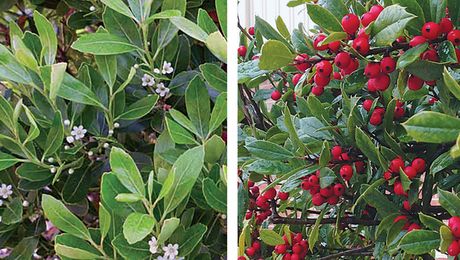
One of my greatest challenges as a designer and deer-plagued gardener is unpredictability. There are no rules. No guarantees. Just guidelines. I’ve watched deer devour thorny shrubs and trample fragrant lavender in order to reach the roses behind them. And tastes vary with the herd, season, climate, and availability.
Diversity seems to be key to disrupting their fickle taste-testing—which is a great excuse to experiment with the combinations shown here, all of which have survived multiple seasons with less-than-fatal browsing.
Exuberant, but contained
Forced restraint is the theme here. Flowering flannelbush is espaliered against the house walls; ‘Fireglow’ spurge is corralled by surrounding paving stones; decorative containers encase tender plants, ensuring size control as well as ease of transport; and a berried cotoneaster is carefully pruned to resemble a bejeweled octopus. On the ground plane, fragrant ‘Elfin’ thyme creeps between flagstones, softening the patio while also contrasting with the many spiky plant forms and textures.
1. Cotoneaster (Cotoneaster spp. and cvs., Zones 4–8)
2. White-striped century plant (Agave americana ‘Mediopicta Alba’, Zones 8–10)
3. ‘California Glory’ flannelbush (Fremontodendron ‘California Glory’, Zones 8–10)
4. ‘Howard McMinn’ manzanita (Arctostaphylos densiflora ‘Howard McMinn’, Zones 7–10)
5. New Zealand flax (Phormium tenax, Zones 8–11)
6. ‘Fireglow’ spurge (Euphorbia griffithii ‘Fireglow’, Zones 4–9)
7. Crown of thorns (Euphorbia milii, Zones 9–11)
8. ‘Elfin’ thyme (Thymus serpyllum ‘Elfin’, Zones 4–8)
9. ‘Yellow Wave’ New Zealand flax (Phormium ‘Yellow Wave’, Zones 8–11)
Get the cottage garden vibe
In a contemporary twist on the English cottage garden aesthetic, lavender, geranium, and white coneflowers mingle unapologetically with rich purple barberry and pale feathery grasses, ensuring color, fragrance, and flowers for many months. If barberries are invasive in your area, substitute with Midnight Wine® weigela (Weigela florida ‘Elvera’, Zones 5–8).
1. ‘Grosso’ lavender (Lavandula × intermedia ‘Grosso’, Zones 5–8)
2. Rozanne geranium (Geranium ‘Gerwat’, Zones 5–8)
3. Mexican feather grass (Nassella tenuissima, Zones 7–11)
4. ‘White Swan’ coneflower (Echinacea purpurea ‘White Swan’, Zones 3–9)
5. ‘Concorde’ barberry (Berberis thunbergii* ‘Concorde’, Zones 5–8)

Add a dash of heat to a cool combination
Weaving together velvety lambs’ ears, stiff-needled conifers, and wispy grasses creates an evergreen, textural feast that shades out weeds with style. The cool silver and blue threads of this unique carpet are enlivened by the warm orange highlights—an unexpected yet welcome color contrast.
1. ‘Helene von Stein’ lambs’ ears (Stachys byzantina ‘Helene von Stein’, Zones 4–9)
2. Orange hair sedge (Carex testacea, Zones 7–9)
3. ‘Blue Star’ juniper (Juniperus squamata ‘Blue Star’, Zones 4–8)

Colorful foliage changes through the seasons
A framework of colorful foliage ensures an eye-catching scene even before the golden black-eyed Susans begin to shine in summer. A deep burgundy plum tree and smokebush offer high contrast to chartreuse foliage, while a transparent scrim of tall verbena interjects the element of surprise. This scene will include bold, fiery shades of red and orange in fall as the smoke bush and Arkansas bluestar take center stage.
1. Arkansas bluestar (Amsonia hubrichtii, Zones 5–8)
2. ‘Grace’ smokebush (Cotinus ‘Grace’, Zones 5–8)
3. ‘Gateway’ Joe Pye weed (Eutrochium maculatum ‘Gateway’, Zones 3–8)
4. ‘Thundercloud’ cherry plum (Prunus cerasifera* ‘Thundercloud’, Zones 5–8)
5. ‘Forever Goldie’ western red cedar (Thuja plicata ‘Forever Goldie’, Zones 5–7)
6. Golden locust (Robinia pseudoacacia* ‘Frisia’, Zones 4–9)
7. Tall verbena (Verbena bonariensis, Zones 7–11)
8. Black-eyed Susan (Rudbeckia fulgida var. sullivantii ‘Goldsturm’, Zones 4–9)

Don’t forget the smaller moments
Spiky bracts of blue sea holly pierce a softly billowing carpet of sweet alyssum, creating layers of blue and white blooms. Both plants are remarkably drought tolerant once established and have proved to be deer and rabbit resistant in my garden, yet they attract many different pollinators.
1. ‘Sapphire Blue’ sea holly (Eryngium ‘Sapphire Blue’, Zones 4–9)
2. Sweet alyssum (Lobularia maritima*, annual)

Every kind of plant is at your disposal
Evergreen conifers jostle with deciduous shrubs, perennials, and flowering bulbs in an inspiring medley of textures and color. The blue-needled fir stands as a bold counterpoint to the large boulders and balances the willowlike silver foliage of a weeping willowleaf pear. Mounding shrubs add structure, perennial flowers and bulbs introduce seasonal interest, and a carpet of silver artemisia knits the ground plane together. The entire combination is surprisingly drought tolerant as well as deer resistant.
1. Black-eyed Susan (Rudbeckia fulgida var. sullivantii ‘Goldsturm’, Zones 4–9)
2. ‘Millenium’ ornamental onion (Allium ‘Millenium’, Zones 4–8)
3. ‘Silver Brocade’ artemisia (Artemisia schmidtiana ‘Silver Brocade’, Zones 3–8)
4. Dwarf blue corkbark fir (Abies lasiocarpa ‘Glauca Compacta’, Zones 3–7)
5. ‘Ogon’ spirea (Spiraea thunbergii ‘Ogon’, Zones 4–8)
6. Weeping willowleaf pear (Pyrus salicifolia ‘Pendula’, Zones 4–7)
7. ‘Blue Shag’ eastern white pine (Pinus strobus ‘Blue Shag’, Zones 3–8)
8. ‘Orange Rocket’ barberry (Berberis thunbergii* ‘Orange Rocket’, Zones 4–9)
*These plants may be considered invasive in your area.
Karen Chapman is a landscape designer in Duvall, Washington, and the author of Deer-Resistant Design. Photos by the author.
Fine Gardening Recommended Products

3 Pack 4.1Inch Bonsai Pruning Scissors
Fine Gardening receives a commission for items purchased through links on this site, including Amazon Associates and other affiliate advertising programs.

Planting in a Post-Wild World: Designing Plant Communities for Resilient Landscapes
Fine Gardening receives a commission for items purchased through links on this site, including Amazon Associates and other affiliate advertising programs.


















Comments
Log in or create an account to post a comment.
Sign up Log in